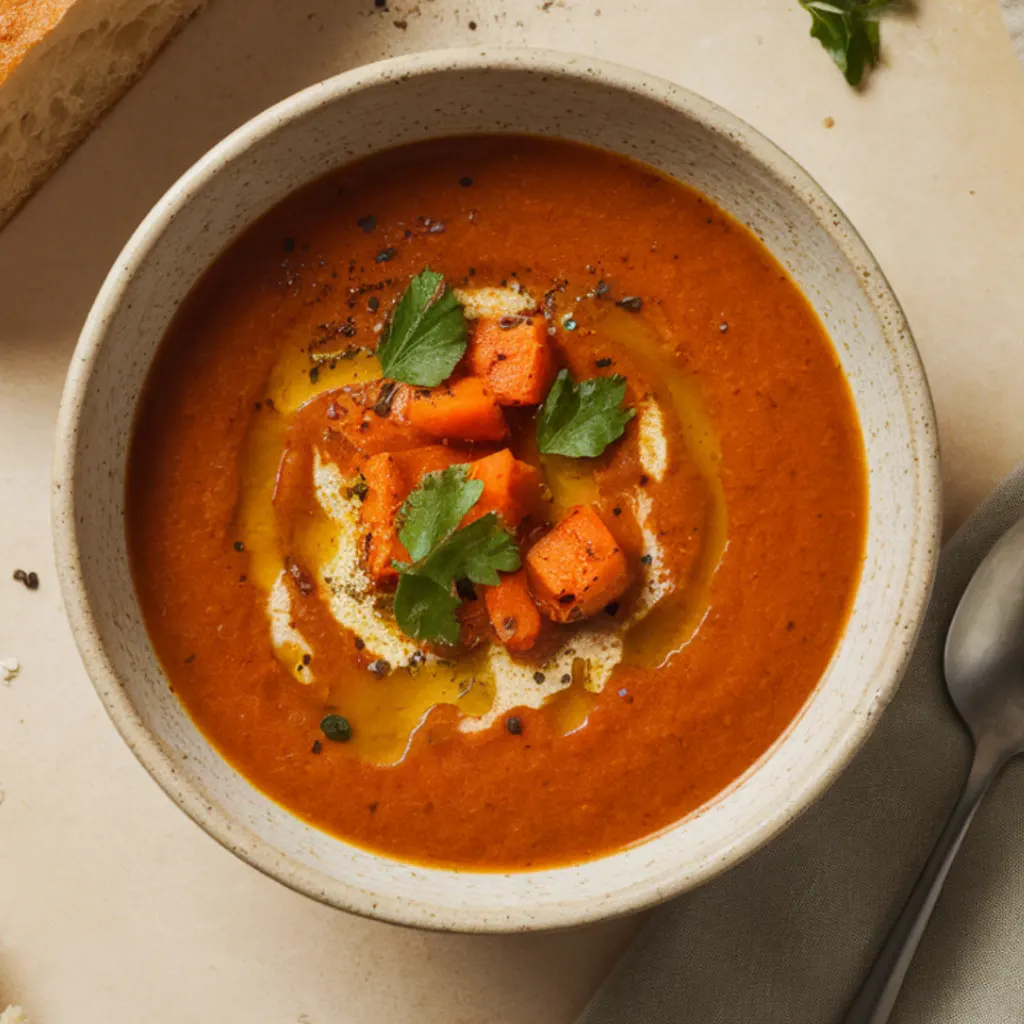There’s something deeply satisfying about making Roasted Winter Vegetable Soup on a chilly evening. Maybe it’s watching root vegetables transform into golden, caramelized perfection in your oven, or perhaps it’s that first spoonful that tastes like you spent hours in the kitchen—even though you didn’t. This soup has become my cold-weather staple, the recipe I turn to when I need both nourishment and a little kitchen therapy.
The secret? Roasting vegetables before simmering them. This simple step creates layers of sweetness and depth that stovetop-only soups just can’t match. You’re essentially giving your vegetables a flavor boost before they even meet the stockpot. And here’s what makes this recipe feel like a warm hug: it’s genuinely easy. No complicated techniques, no hard-to-find ingredients—just honest vegetables treated well.
Winter is when root vegetables shine brightest. From November through March, carrots, parsnips, and butternut squash are at their sweetest and most affordable. This soup feels special enough for weekend company but practical enough for Tuesday night when everyone’s tired and hungry. Plus, it makes your house smell absolutely incredible while it roasts.
*Before You Start: You’ll find more explanation here than a basic recipe. That’s intentional—the aim is to educate, not just instruct.
What Makes This Winter Soup So Damn Good
❃ Your kitchen does the heavy lifting: Once those veggies hit the oven, you’ve got 30 minutes to yourself
❃ Tastes like you fussed (but you didn’t): The roasting creates depth that feels way more impressive than the effort required
❃ Freezer is your friend: Make a double batch and stash portions for those nights when cooking feels impossible
❃ Budget-friendly comfort: Root vegetables are affordable, especially in winter when they’re in season
❃ Flexible and forgiving: Use whatever root veggies look good at your store—this recipe is wonderfully adaptable
❃ Naturally creamy without cream: Blending creates silky texture without dairy, which means it’s lighter but still satisfying
Gather These Fresh Winter Staples
For Roasting:
• 3 medium carrots, peeled and cut into 1-inch chunks (about 1½ cups)
• 2 medium parsnips, peeled and cut into 1-inch chunks (about 1 cup) — If you haven’t tried parsnips yet, think of them as sweeter, more delicate carrots
• 1 medium turnip, peeled and cut into 1-inch chunks (about 1 cup) — Turnips get milder and sweeter when roasted
• 1 small butternut squash, peeled, seeded, and cut into 1-inch chunks (about 2 cups) — Honestly? Buy the pre-cut kind. Life’s too short for wrestling with butternut squash
• 1 large yellow onion, cut into wedges — Keep the root end attached so wedges stay together while roasting
• 4 garlic cloves, unpeeled — Roasting them in their papery skins makes them sweet and prevents burning
• 3 tablespoons olive oil
• 1½ teaspoons kosher salt
• ¾ teaspoon black pepper
• 1 teaspoon dried thyme — Fresh works beautifully too—use about 1 tablespoon
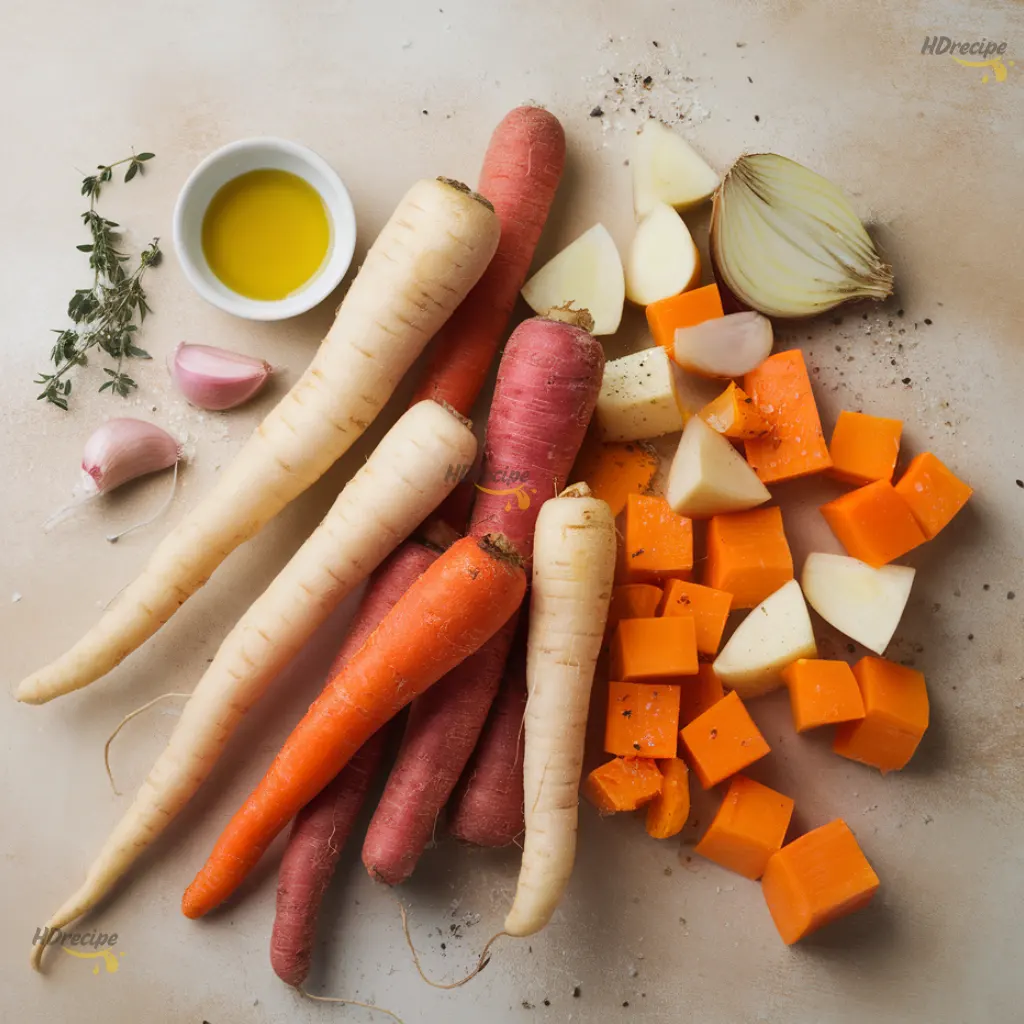
For the Soup:
• 6 cups vegetable or chicken stock — This is where quality matters. Good stock makes good soup
• 1 bay leaf
• 1 tablespoon apple cider vinegar — Trust me on this one—it brightens everything without tasting vinegary
• Salt and black pepper to taste
For Serving (Optional but Lovely):
Crusty bread, toasted and rubbed with garlic
• Fresh parsley, roughly chopped
• A drizzle of your best olive oil
• Crunchy toppings like croutons or toasted pepitas
Quick Note: No parsnips? Use extra carrots. Swap turnip for rutabaga or sweet potato. Can’t find butternut squash? Any winter squash works, or even sweet potatoes (though they’ll make it sweeter).
How to Bring It All Together
1 Get your oven ready and prep your veggies
Preheat your oven to 425°F—we want it nice and hot for proper caramelization. Line a large baking sheet with parchment paper if you’ve got it (makes cleanup easier), or just use it bare. Cut all your vegetables into similar-sized pieces, about 1-inch chunks. This matters more than you might think—uniform pieces roast evenly, preventing some from burning while others stay pale and sad.
2 Season and spread your vegetables
Pile all your chopped vegetables, onion wedges, and those whole garlic cloves onto the baking sheet. Drizzle everything with olive oil, then sprinkle on the salt, pepper, and thyme. Now get your hands in there and toss everything together until it’s well coated. Here’s the important part: spread everything in a single layer with a bit of breathing room between pieces. Crowded vegetables steam instead of roast, and we’re after those gorgeous caramelized edges.
3 Let the oven work its magic
Roast for 30–35 minutes, giving everything a good stir about halfway through. You’ll know they’re ready when the edges are deeply golden brown with some darker caramelized spots. The garlic should feel soft when you gently squeeze it. If things look pale after 30 minutes, give them another 5 minutes. Those browned bits are pure flavor—don’t be afraid of them!
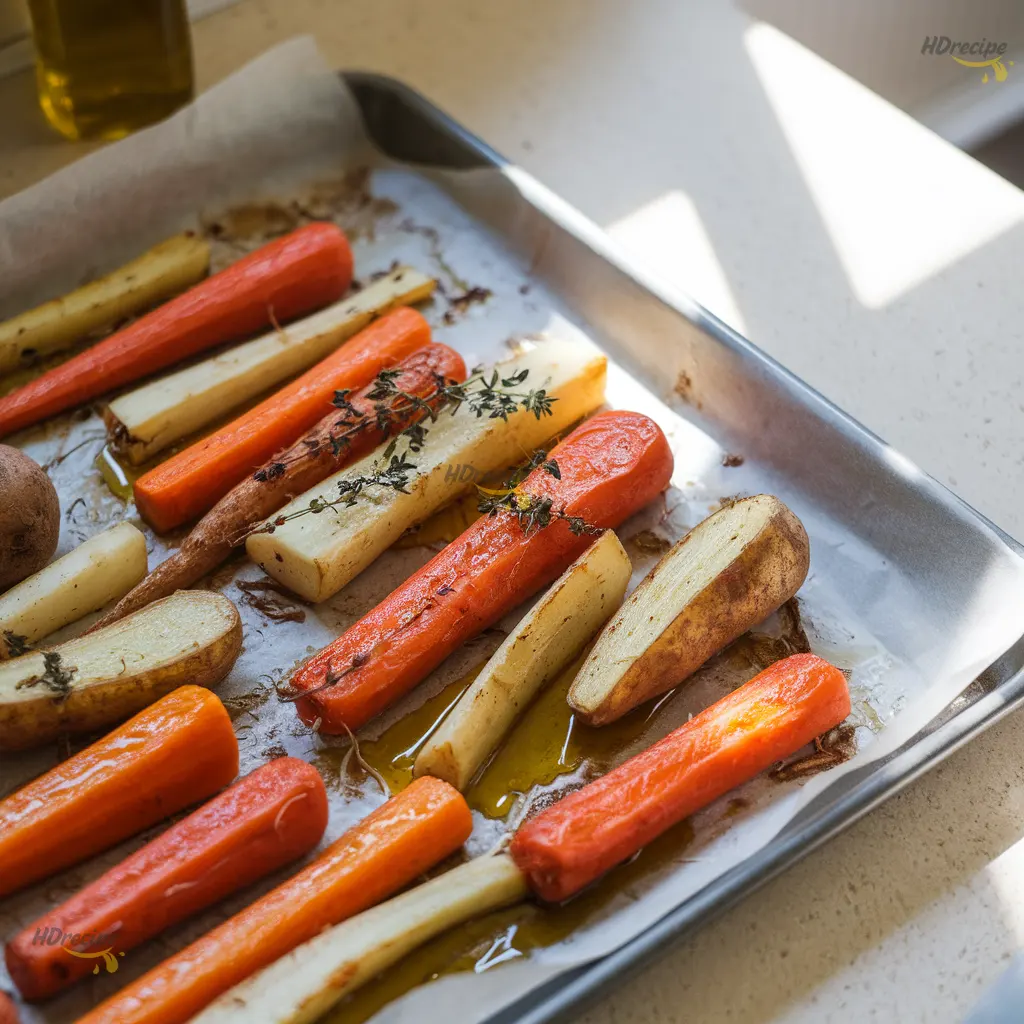
4 Squeeze out that roasted garlic goodness
While your vegetables finish roasting, grab a small bowl. Once the garlic is cool enough to handle, squeeze those soft cloves right out of their skins and mash them with a fork. It’ll be sweet, mellow, and nothing like raw garlic—roasting transforms it completely.
5 Build your soup base
Transfer all those beautiful roasted vegetables into a large soup pot or Dutch oven—don’t forget to scrape up any browned bits stuck to the pan. Add your mashed roasted garlic, stock, and bay leaf. Bring everything to a boil over medium-high heat, then turn it down to a gentle simmer. Let it bubble quietly for about 10 minutes so all those flavors can get to know each other.
6 Blend to your perfect texture
Fish out that bay leaf, then grab your immersion blender. Blend about half the soup right in the pot, leaving plenty of chunks for texture. (If you’re using a regular blender, work in batches and only fill it halfway—hot soup and full blenders don’t mix well, trust me.) The partial blending gives you the best of both worlds: creamy but still interesting.
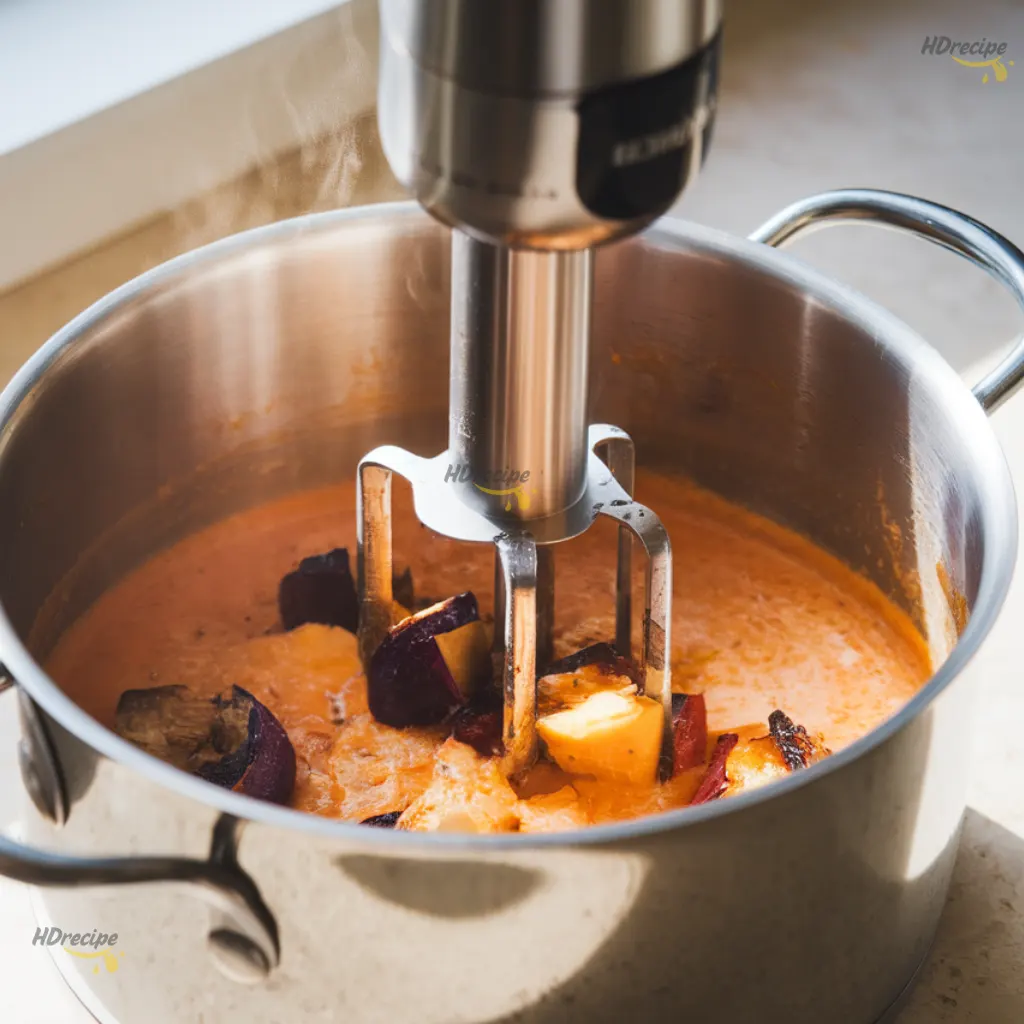
7 The finishing touches that make it shine
Stir in that apple cider vinegar—this is the secret ingredient that makes everything pop. Now taste it. Really taste it. Roasted vegetables need more salt than you might expect, so adjust with salt and pepper until it makes you happy. This step is where good soup becomes great soup.
8 Serve with love
Ladle your Roasted Winter Vegetable Soup into bowls. Drizzle with good olive oil, scatter some fresh parsley on top, and serve with toasted bread for dipping. The soup tastes even better the next day, so don’t feel pressured to finish it all tonight.
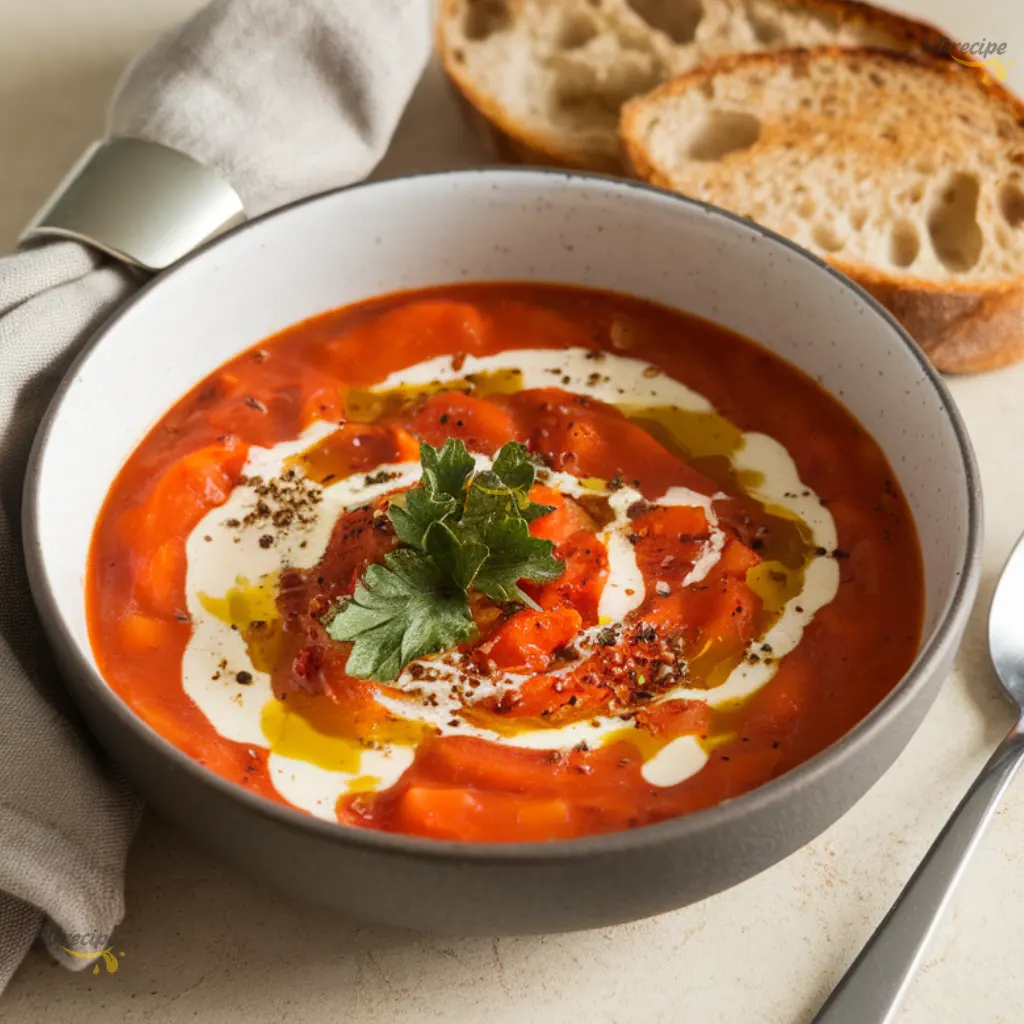
Don’t Skip These Flavor Tricks
❃ The size thing is real: When vegetable pieces are all different sizes, you’ll have burnt little bits and undercooked big chunks. Take an extra minute to make them uniform—it makes such a difference.
❃ Don’t skip the halfway stir: I learned this the hard way. The bottom layer can burn while the top stays pale if you don’t flip everything around midway through roasting.
❃ Make it your own thickness: Want it thicker? Blend more. Prefer it brothier? Blend less or add another cup of stock after blending. There’s no wrong answer here—it’s your soup!
❃ Taste before you serve: This is where so many home cooks stop short. That final seasoning adjustment transforms good soup into “where did you get this recipe?” soup.
❃ Prep ahead when you can: Sunday afternoon? Chop all your vegetables and store them in a container. Tuesday evening? Just dump them on a pan and roast. Future you will be so grateful.
Quick Nutrition Breakdown
Based on 6 generous servings
• Calories: 165
• Carbohydrates: 24g
• Protein: 3g
• Fat: 7g
• Fiber: 5g
• Sugar: 9g
• Sodium: 620mg
❃ Nutrition information is estimated and may vary depending on specific ingredients and portion sizes.
Things You’ll Probably Wonder While Making This
➲ Can I make this ahead? How long does it keep?
Absolutely! This soup is actually one of those magical recipes that tastes even better the next day. Store it in an airtight container in the fridge for up to 5 days. For longer storage, freeze portions in containers or freezer bags for up to 3 months. When reheating, add a splash of stock if it’s thickened up—soup tends to do that in the fridge.
➲ I don’t have an immersion blender—will a regular blender work?
Yes! Just let the soup cool for a few minutes first, then blend in batches. Fill your blender only halfway (hot soup expands and can overflow), and hold a kitchen towel over the lid while blending. You can also use a potato masher if you want a chunkier, more rustic texture. It won’t be quite as creamy, but it’ll still be delicious.
➲ How can I make this more filling?
Great question! Stir in a can of white beans or chickpeas during that final simmer. If you’re not vegetarian, shredded rotisserie chicken stirred in at the end or crispy bacon crumbled on top both add protein and make it feel more substantial. Serving it with hearty bread or a grilled cheese on the side also does the trick.
➲ My soup tastes kind of flat—what went wrong?
Usually, it’s one of two things: not enough salt or not enough roasting. Vegetables need generous seasoning, especially after blending dilutes the flavors. Taste and add more salt, even if it feels like a lot. If the flavor is bland even with salt, the vegetables might not have caramelized enough during roasting. Next time, make sure you see those dark golden-brown edges before moving to the soup pot.
One Last Spoonful of Truth
Here’s what I love most about this Roasted Winter Vegetable Soup: it makes you feel like a really good cook without actually being difficult. That roasting step does all the heavy lifting, creating depth and complexity while you do something else entirely. It’s the kind of recipe that becomes part of your regular rotation because it’s both impressive and doable.
If you’re in a soup mood, you might also love my:
❃ Easy Hearty Beef Barley Soup (One-Pot Wonder!)
❃ Easy Cheesy Potato Soup (7 steps!): Creamy, Quick & Cozy
❃ Easy & Creamy Scalloped Potatoes Recipe (Feeds 10 People!)
❃ Easy Chicken Enchilada Recipe: 8 Steps to Cheesy Perfection
Made this recipe? I’d genuinely love to hear how it turned out! Leave a comment below with your thoughts, tweaks, or questions. And if you snap a photo, tag me on Pinterest—seeing your versions always makes my day. If this recipe worked for you, leaving a rating helps other home cooks find it too.
Stay cozy out there!
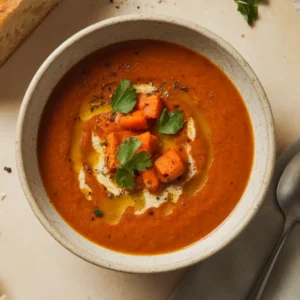
The Best Roasted Winter Vegetable Soup You’ll Make All Season
Ingredients
For Roasting:
- 3 medium carrots peeled and cut into 1-inch chunks
- 2 medium parsnips peeled and cut into 1-inch chunks
- 1 medium turnip peeled and cut into 1-inch chunks
- 1 small butternut squash peeled, seeded, and cut into 1-inch chunks (about 2 cups)
- 1 large yellow onion cut into wedges
- 4 garlic cloves unpeeled
- 3 tablespoons olive oil
- 1½ teaspoons kosher salt
- ¾ teaspoon black pepper
- 1 teaspoon dried thyme
For the Soup:
- 6 cups vegetable or chicken stock
- 1 bay leaf
- 1 tablespoon apple cider vinegar
- Salt and black pepper to taste
For Serving (Optional):
- Fresh parsley chopped
- Extra virgin olive oil
- Crusty bread
- Croutons or toasted pepitas
Instructions
- Preheat oven to 425°F. Line a large baking sheet with parchment paper. Cut all vegetables into uniform 1-inch chunks for even roasting.
- Place carrots, parsnips, turnip, butternut squash, onion wedges, and whole garlic cloves on the baking sheet. Drizzle with olive oil and sprinkle with salt, pepper, and thyme. Toss to coat evenly, then spread in a single layer with space between pieces.
- Roast for 30-35 minutes, stirring halfway through, until vegetables are deeply golden brown with caramelized edges. Garlic should be soft when gently squeezed.
- Squeeze roasted garlic from skins and mash in a small bowl. Transfer all roasted vegetables and any browned bits to a large soup pot. Add mashed garlic, stock, and bay leaf.
- Bring to a boil, then reduce heat and simmer for 10 minutes. Remove bay leaf. Use an immersion blender to puree about half the soup, leaving chunks for texture.
- Stir in apple cider vinegar. Taste and adjust seasoning with salt and pepper as needed. Serve hot with a drizzle of olive oil, fresh parsley, and crusty bread.
